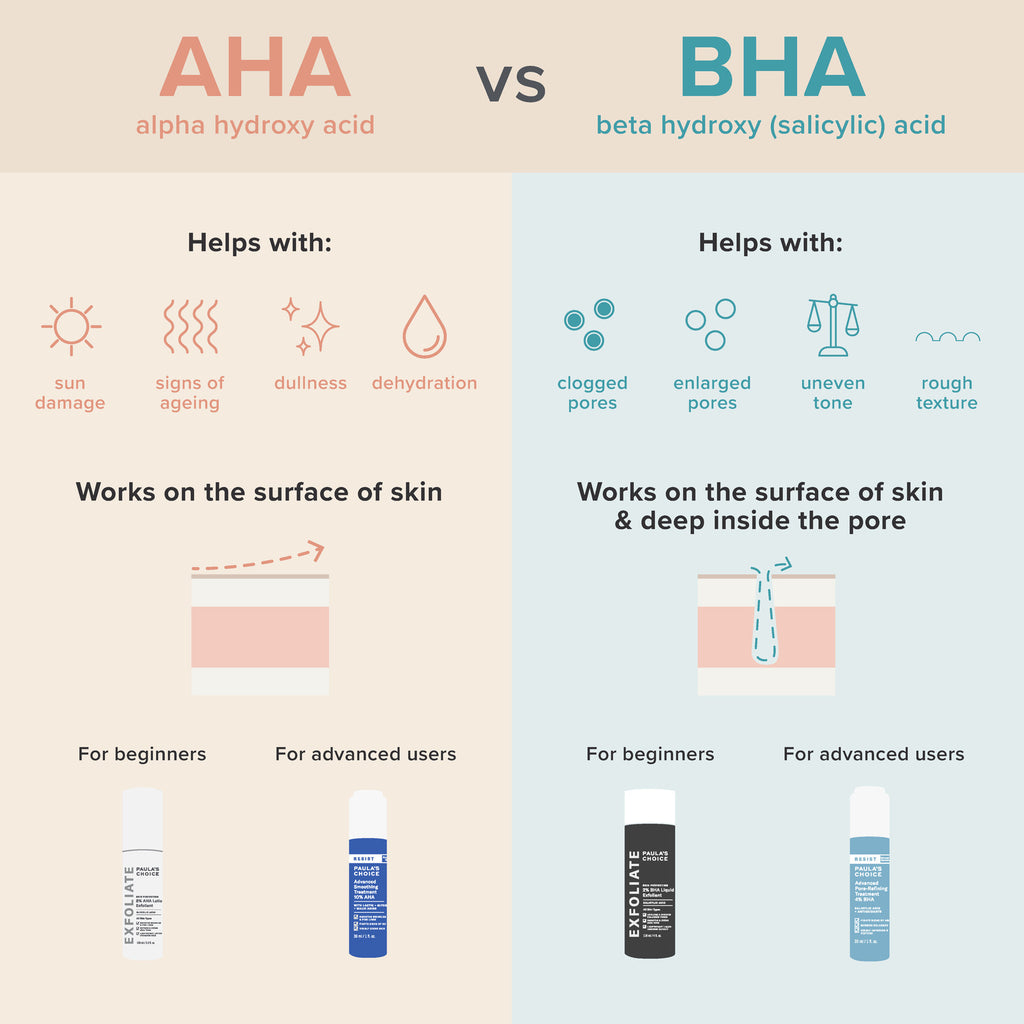Written by:Desiree Stordahl
Medically Reviewed by:Beth McLellan MD Board-Certified Dermatologist
If you haven’t been using an AHA (alpha hydroxy acid) or BHA (beta hydroxy acid) exfoliant, your skin is missing out on significant benefits. These non-abrasive, leave-on exfoliants work more effectively than scrubs and offer additional benefits, including:
- minimizing the appearance of wrinkles
- clarifying dull, uneven skin tone
- smoothing rough, bumpy skin
- unclogging pores
- increasing hydration
What is exfoliating skin?
Exfoliating skin entails removing built-up dead skin cells that aren’t shedding efficiently and have accumulated on the surface/inside pores. While exfoliation can be done using a physical scrub or manual tool such as a cleansing brush, chemical exfoliants with AHA or BHA are preferred by skin care experts and dermatologists as a more effective, gentle option.
When we’re young, healthy skin does a good job of shedding on its own without any outside help, but over time, due to unprotected sun exposure and age, skin’s natural ability to exfoliate slows down.
Why skin exfoliation is so important
Exfoliation is important because getting rid of built-up dead skin helps minimize issues such as rough/flaky texture, dull or uneven tone and clogged pores. Exfoliation can also help wrinkles look less exaggerated and soften the appearance of other signs of aging. Essentially, it unveils a healthier-looking, smoother-feeling version of your skin.
How to exfoliate face and body (and get the most out of it)
- Apply your exfoliant after you cleanse and tone.
- Apply an occasional-use rinse-off exfoliant peel to cleansed skin and rinse after several minutes.
- You can exfoliate around the eye area, but not the eyelid or directly under the eye (along the lower lash line).
- You don’t need to wait for your BHA or AHA to absorb or dry; you can apply any other product in your routine—moisturizer, serum, eye cream, or sunscreen—immediately afterward.
- Experiment with different strength exfoliants to see which concentration gives you the best results. That might mean weekly use of an at-home chemical peel.
- Some people do well exfoliating with AHA or BHA twice daily, whereas others find that once a day or every other day is the perfect balance. Note how your skin responds and adjust accordingly.
- Exfoliating with AHA or BHA from the neck down has great benefits as well.
How often should you exfoliate skin?
How often you should exfoliate comes down to your skin’s needs and tolerability. Those with stubborn concerns (like bumps, clogs, acne or advanced signs of sun damage) may do well exfoliating with AHA or BHA twice daily. Others will find application once daily or even once every few days to be their skin’s sweet spot. It can take some experimenting to find the right cadence.
What body and face exfoliator should you use?
AHA exfoliants are most helpful for dry skin with advanced signs of aging. AHA products smooth wrinkles and fine lines, help with rough, crepey texture and leave you with hydrated, supple skin and a healthy glow. Research also shows them to be effective at minimizing the visible signs of sun damage.
BHA exfoliants are ideal if you’re dealing with clogged pores, blackheads, blemishes or enlarged pores, as well as signs of aging. We have products specifically formulated for easily aggravated skin and acne, as well as more general concerns. Our BHA exfoliants can reduce the appearance of small white bumps and are even suitable for those with skin prone to milia and/or rosacea. Dr. Beth McLellan points out that BHA-containing products can be safely used on all skin types, including those with more pigmented skin.

How to exfoliate sensitive skin
To exfoliate sensitive skin, opt for a BHA exfoliant in a 1% concentration. BHA has inherent skin-calming and soothing properties, which makes it the ideal choice for those with temperamental skin. If your skin responds well and you want to see what kind of results you can get from a higher concentration, graduate to 2% BHA.
Why not use a face scrub? Most facial scrubs have rough, coarse textures, which can be harsh and abrasive, causing micro-tears in skin. The stiff bristles of many cleansing brushes have the same negative impact on skin’s vulnerable surface. Gentle face scrubs and soft cleansing brushes are the exception, but even those are best used as an extra cleansing step, not as a replacement for a well-formulated AHA or BHA exfoliant. Scrubs simply don’t work as deeply or effectively as AHA and BHA exfoliants, nor do they offer the same skin-transforming benefits. Dr. McLellan notes “many of my patients don’t realize that a good exfoliating product can work as well as manually scrubbing the skin and cause less irritation.”
Learn more about exfoliants.
References for this information:
- Dermatology Research and Practice, February 2015, ePublication
- Journal of the German Society of Dermatology, July 2012, pages 488–491
- The Journal of Clinical and Aesthetic Dermatology, May 2012, pages 32-40
- Clinical, Cosmetic, and Investigational Dermatology, November 2010, pages 135–142
- Journal of the American Academy of Dermatology, April 2007, pages 651–663
- Clinics in Dermatology, July 2001, pages 460–466
- Archives of Dermatologic Research, July 1997, pages 404–409








